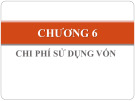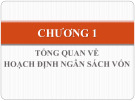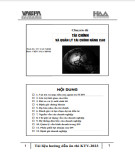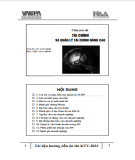
ISSN 1859-1531 - TẠP CHÍ KHOA HỌC VÀ CÔNG NGHỆ - ĐẠI HỌC ĐÀ NẴNG, VOL. 22, NO. 8, 2024 19
APPROPRIATE INDEXES TO MEASURE FINANCIAL CONSTRAINTS OF
VIETNAMESE FIRMS
CHỈ SỐ PHÙ HỢP ĐỂ ĐO LƯỜNG SỰ HẠN CHẾ TÀI CHÍNH CỦA
CÁC DOANH NGHIỆP VIỆT NAM
Thai Thi Hong An*, Ha Le Hong Ngoc
The University of Danang - University of Economics, Vietnam
*Corresponding author: antth@due.edu.vn
(Received: February 19, 2024; Revised: July 16, 2024; Accepted: August 25, 2024)
Abstract - This paper focuses on testing the applicability of
various financial constraints measurements in the context of the
Vietnamese market. Using a sample of non-financial quoted firms
throughout 2010-2019; our paper contributes to current corporate
finance literature with a novel and simple measurement of
financial shortages that is effectively applicable for Vietnamese
firms, namely the Age-size-cash flow- interest coverage index
(ASCIC). The index is the combination of age and size, which
reflect information asymmetry; cash flow, and interest cover ratio
that present repayment capacity and solvency risk respectively.
The outcomes indicate that while the ASCIC index produces
measurement results comparable to other indices, it utilizes a
more straightforward calculation method. In light of Vietnam as
a country with considerable development potential but substantial
financial limitations, it is imperative to identify a financial
constraint measurement index that is both simple and effective.
Tóm tắt - Bài báo này tập trung vào việc kiểm tra tính phù hợp
của các chỉ số dung để đo mức độ hạn chế tài chính doanh nghiệp
trong bối cảnh thị trường Việt Nam. Sử dụng mẫu các công ty
niêm yết giai đoạn 2010-2019; bài báo đóng góp một phép đo mới
và đơn giản về tình trạng hạn chế tài chính của các công ty Việt
Nam, gọi là chỉ số ASCIC. Chỉ số này là sự kết hợp của tuổi và
quy mô, phản ánh sự bất đối xứng thông tin; dòng tiền và khả
năng trả lãi - thể hiện khả năng trả nợ và rủi ro thanh toán. Kết
quả cho thấy trong khi ASCIC đưa ra kết quả đo lường có hiệu
quả tương đương với các chỉ số khác, nó được tính toán đơn giản
hơn. Xét đến việc các công ty Việt Nam có nhiều tiềm năng mở
rộng hoạt động kinh doanh của mình nhưng lại phải đối mặt với
những hạn chế đáng kể về mặt tài chính, việc xác định một chỉ số
đo lường khó khăn tài chính vừa đơn giản vừa hiệu quả là điều
cần thiết.
Key words - Investment; cash flow; financial constraints; index;
Vietnam
Từ khóa - Đầu tư; dòng tiền; hạn chế tài chính; chỉ số, Việt Nam
1. Introduction
Identifying appropriate proxies of financial constraints
has been an issue of debate, as financial constraints are not
only the key to studying the impact of financing shortage on
investment, capital structure, and risk management
strategies but also relate to topics ranging from the cross-
section of returns to the transmission of monetary policy [1].
As financial constraints are elusive, it is usually measured
indirectly either by the level of estimated investment-cash
flow sensitivities or through related variables of financial
constraints, such as information asymmetric or agency costs
[2]. Currently, four popular indexes often used to evaluate
firms’ budget limitations, including the Kaplan-Zingales
index [3] (KZ hereafter), Whited-Wu index [4] (WW
hereafter), Size-Age index [5] (SA hereafter), and Age-size-
cash flow-leverage index [6] (ASCL hereafter). However,
each of them has its own weakness that make them may not
be applicable to all market samples [7]. This means that
when studying with a single-country sample, it is crucial to
identify the suitable metric for financial constraints.
This paper focuses on Vietnam, where the capital
market is characterized by some adverse financial
attributes, such as insufficient market information, loose
corporate governance mechanisms, and problem of
financial restrictions. This, in turn, has limited the entry
into financial markets for financially constrained firms,
which has been an evident phenomenon of the Vietnam
financial system especially.
Our study contributes to existing literature in some
aspects. First, in the context of Vietnamese market,
comparing among common measurements of financial
constraints; we document that WW and ASCL are the most
appropriate ones. Second, we construct a new index called
Age-size-cash flow-interest coverage (ASCIC hereafter).
In particular, ASCIC is the combinations of age, size, cash
flow position, and the interest coverage ability of firms.
With this new metric, constrained firms are those firms that
face information asymmetric problems, and have low
repayment capacity and high solvency risk. This
approach’s main advantage is that it is based on a simple
scoring system, so it is easy to calculate when being as
efficient as other popular indexes. Considering Vietnam's
status as a nation with substantial development potential
but significant financial constraints, it is crucial to identify
a financial constraint measurement index that is both
simple and effective. This allows not only firm managers
but also policymakers to easily evaluate the financial status
of firms, enabling them to implement timely and
appropriate solutions to address firm financial challenges
and enhance their operational efficiency.
2. Literature review and new index development
2.1. Existing indexes of financial constraints
Empirical studies find several measurements to partition

20 Thai Thi Hong An, Ha Le Hong Ngoc
firms into financially constrained/unconstrained groups, but
there are still no approaches that everyone can agree on. The
literature has provided many possibilities, including KZ,
WW, SA, and ASCL index, which will be described in more
detail below. There are various causes of existential debate
following the relative merits of each approach, for example,
the validity of empirical or theoretical assumptions that
these methods rely on. Additionally, some of these
approaches are based on endogenous financial selections
that may not be in straightforward correlation with financial
constraints. For instance, it is the fact that, while external
cash rising may contribute to releasing the constraints of a
firm, a high level of cash holding that serves a precautionary
motive, on the other hand, may also be an indication of
constrained status [5].
The KZ index is known as one of the most popular
approaches in sorting firms into constrained or
unconstrained groups. [8] developed this index from the
version of [3]. In comparison with [3], who use a sample
of manufacturing companies with positive net sales growth
over 1969- 1984 period, [8] increase their findings
applicability by narrowing their focus on a sample
accounting for manufacturing enterprises with positive
actual sales growth in the last year. It is noticeable that, by
design, [8]’s approach consists of a larger number of
enterprises in a constrained group than that according to the
KZ classification scheme. In which, while [8] identify
firms as "constrained" if they are in the top 33% of all firms
each year, [3] the study concentrates only on low-dividend
firms as they argue that only 15% of the firms are more
likely to be budget limited. In terms of methodology, while
[3] employ a logit regression to link their identifications to
5 accounting variables (i.e., Cash flow/Total assets;
Tobin’s Q; Long-term debt/ Total assets; Dividend/Total
assets; Cash holding/Total assets) to sort firms into
constrained categories, [8] depend on regression’s
coefficients to generate an index that is a linear
combination of these five ratios. As designed, the higher
the KZ index, the higher the likelihood of being
constrained.
WW Index is another popular measurement generated
by [4]. Different from the widely used KZ index, WW is
based on firm characteristics that may present external
finance constraints. Furthermore, most of the components
of this index present for asset returns. By design, firms that
display a high WW index will be sorted in a constrained
category. In particular, those are often small, under-invest,
and have low bond-ratings. In contrast, following KZ,
constrained firms are large, over-invest, and have high
bond-ratings [4].
SA index is constructed by [5]. In which, financial
constraint is modelled as a nonlinear function of firm size
and age. The relationship can be explained as follows: the
nature of small firms is high business-individualistic and
bankruptcy risks, which may either prevent them from
obtaining an external source of finance or increase the cost
of accessing external funds. Additionally, small firms
might have a short operating history, which may exclude
them from being able to access credit markets [7]. SA
index implies that when small firms become more mature,
their financial constraints would be sharply lower. In other
words, the higher the index value, the greater the firm’s
financial constraint status is.
Age-size-cash flow-leverage index (ASCL) of [6] can
be considered as the first score-based index of budget
restrictions, which is the main inspiration for us to conduct
the current study. In a study of unquoted firms from 6
European countries, [6] build an index, which captures firm
age, size, cash flow, and leverage. These elements were
explained as the best proxy for information asymmetry (age,
and size), the repayment capacity (cash flow), and the level
of default risk (leverage ratio). [6] agree with [5] that age,
and size are the most valid shifters of the fund supply curve.
While the larger firms are favoured by financial institutions
since they are less likely to face informative asymmetry
issues, and have lower risk of default in comparison to small
firms, the older companies have transparent credit history
records that credit suppliers can base on to decide whether
to provide loans or not. Apart from age and size, [6] state
that cash flow could describe firms’ capacity of repayment
while long-term debt ratios affect banks’ willingness to
provide credit directly. Less indebted firms are preferred
since they are less likely to be insolvent.
ASCL of a firm lies within the lowest point at 0 (i.e.
lowest possibility of constraints) to the highest score of 4
(i.e. highest constraints). Firms who have the point of 0 are
the old, large businesses with high availability of cash flow
and high capacity to cover the debt obligations. Thus, they
have the lowest ability to fall into budget constraints. The
opposite scenario can be seen with firms getting 4.
2.2. New index construction
In this section, we construct a new index called ASCIC.
With ASCIC, we use firm age, size, and cash flow scores
since these elements have undeniable impacts on the
financial situations of firms as shown by studies of [3], [4],
and [6]. The index includes interest coverage ratio since it
can reflect the financial sustainability of a firm. This ratio
shows not only the interest rate bearing by firms and their
amount of debt commitment but also their repayment
capacity.
Compared to other ratios, the interest coverage ratio
provides a clearer picture of a company's ability to meet its
short-term financial obligations than leverage ratios,
particularly in terms of understanding corporate financial
constraints. It directly assesses a company's capacity to pay
interest from its operating income. A higher ratio means the
company has more earnings relative to its interest expenses,
signaling a better ability to service its debt. It focuses on
operational performance (i.e., its calculation is based on
EBIT), and it provides insight into the company's core
earning potential rather than its capital structure or total debt
levels. Besides, it is a strong prediction of financial stress
[9]. A low- interest coverage ratio indicates that a company
might struggle to meet its interest payments, potentially
leading to financial distress or bankruptcy. It reflects
immediate financial stress more effectively than leverage
ratios. A decline in this ratio indicates that a company is
facing operational issues and is struggling with debt

ISSN 1859-1531 - TẠP CHÍ KHOA HỌC VÀ CÔNG NGHỆ - ĐẠI HỌC ĐÀ NẴNG, VOL. 22, NO. 8, 2024 21
repayment, even if leverage ratios seem manageable. In
contrast, leverage ratios emphasize the amount of debt in
relation to equity or assets but do not directly measure the
company's ability to meet its interest obligations. They tell
us how much debt the company has, but not how easily it
can handle interest payments. These ratios can sometimes
give a misleading picture if a company has significant
amounts of debt but also substantial earnings. For example,
a company might have a high debt-to-equity and a debt-to-
asset ratio but still have a high interest coverage ratio,
indicating that it can comfortably service its debt. Besides,
leverage ratios do not provide insight into the company's
operational earnings relative to its debt servicing
requirements. They focus more on the balance sheet
composition rather than cash flows or operational
performance. In short, while leverage ratios are important
for understanding a company’s overall debt levels and
capital structure, the interest coverage ratio provides a more
direct and practical measure of a company's ability to meet
its interest expenses, which is crucial for assessing financial
constraints and potential distress.
Our new index is even simpler than ASCL since the
calculations only involve to a given year, and all scores will
be given 1 if they are smaller than the median of the
industry, so they are easier to compute and use.
The validity of interest coverage ratios in reflecting
firms’ financial status has been demonstrated by many
popular previous studies, including [3] and [4]. For
example, according to [3], least constrained firms display
the strongest investment sensitivity to change in cash flow.
They find that firms with high ratios of interest coverage
have more healthy financial positions and are less likely to
be constrained.
In short, the new index is constructed as follows:
ASCIC = Age score + Size score + Cash flow score
+ Interest coverage score
Where:
Age score = 1 if firm age lower than industry median,
and 0 otherwise;
Size score = 1 if firm size smaller than industry median,
and 0 otherwise;
Cash flow score = 1 if firm cash-flow-to-assets ratio
lower than industry median, and 0 otherwise;
Interest coverage score = 1 if the ratio of interest paid
over total interest-bearing debts is lower than the industry
median and 0 otherwise.
Similar to ASCL, our index can range from the lowest
point at 0 (i.e. lowest possibility of constraints) to the
highest score of 4 (i.e. highest constraints). Firms who have
the point of 0 are the old, large businesses with high
availability of cash flow and high capacity to cover the debt
obligations. Thus, they have the lowest ability to fall into
budget constraints. The opposite scenario can be seen with
firms getting 4.
3. Data
Our data is provided by FiinGroup for the period from
2010 to 2019. We do not include crisis periods (i.e., the
Global financial crisis (2007-2009) and COVID-19 (2020-
2022) to ensure the stability in corporation data).
Information after 2022 is not available. Since in a
developing market like Vietnam, data from listed firms is
more reliable than that of unlisted firms, all investigated
firms are publicly listed firms. We exclude financial
institutions and utility firms as they have many differences
in their operating, investing, and financing activities
compared to the other industries. Then, based on firm-level
data, we calculate five indexes as follows:
Table 1. Index summary
Index
Calculation
WW
–0.091* (Cashflow/Total assets) – 0.062*(Dividend
dummy) – 0.044* Natural-logarithm (Total assets)
– 0.035* Growth-in-sales + 0.102* Industry’s Growth-
in-sales + 0.021*(Long-term debts/Total assets)
Where:
Dividend dummy = one if the firm pays dividend, and
zero otherwise
KZ
–1.002* (Cash flow/Total assets)
– 39.368*(Dividend/Total assets) – 1.315*(Cash
holding/Total assets) + 0.283* Tobin’s Q
+ 3.139*(Long-term debt/ Total assets)
Where:
Q is Tobin’s Q = (Book value of assets - book value of
equity + market value of equity)/Book value of assets
SA
SA = -0.737* Natural-logarithm (Total assets) +
0.043*(Natural-logarithm (Total assets)) ^2 - 0.040*Age
ASCL
Size dummy + Age dummy + Cash flow dummy
+ Long-term leverage dummy
Where:
Size dummy=1 if size is smaller than industry median,
and 0 otherwise
Age dummy = 1 if firm is younger than industry
median, and 0 otherwise
Cash flow dummy = 1 if the average value of cash
flow-to-capital ratio of the previous two years is lower
than the industry median, and 0 otherwise
Long-term leverage dummy = 1 if the average value of
long term-debt-to-assets ratio of the previous two
years is higher than the industry median, and 0
otherwise
ASCIC
Size dummy + Age dummy + Cash flow dummy
+ Interest coverage dummy
Where:
Size dummy=1 if firm’s size is smaller than industry
median, and 0 otherwise
Age dummy = 1 if firm’s age is smaller than industry
median, and 0 otherwise
Cash flow dummy = 1 if firm’s cash flow lower than
the industry median, and 0 otherwise
Interest coverage dummy= 1 if the firm's interest
coverage ratio is lower than industry median, and 0
otherwise.
(Note: Interest coverage ratio = Earnings before
interests and tax/Interest expense)
The statistics summary of the five indexes is presented
below:

22 Thai Thi Hong An, Ha Le Hong Ngoc
Table 2. Statistics summary
N
Mean
Std. Dev.
Min
Max
WW
10,510
-1.191
0.086
-1.541
-1.013
KZ
10,827
-0.622
1.593
-7.534
2.223
SA
14,439
6.183
5.142
-1.960
16.553
ASCL
19,928
1.360
0.767
0
4
ASCIC
19,928
0.764
0.934
0
4
4. Result
First, we perform a Pearson's correlation to assess the
relationship across 5 indexes of financial constraints,
including WW, KZ, SA, ASCL, and ASCIC, to see the
association between them. As can be seen from Table 3,
except for KZ-WW, there are considerable associations
between pairwise splitting schemes. Since we build ASCIC
to use as an alternative measure of ASCL, and they have
some components in common, ASCIC and ASCL are
highly associated with each other.
Table 3. The Pearson correlation coefficient across financial
constraints’ measurements
WW
KZ
SA
ASCL
ASCIC
WW
1
KZ
-0.003
1
SA
-0.360a
0.089a
1
ASCL
0.220a
0.227a
0.167a
1
ASCIC
0.238a
0.153a
0.387a
0.795a
1
c p<0.05, b p<0.01, a p<0.001
The most popular components of indexes used to
measure budget limitation are firm age, size, level of cash
flow, debt ratios, and dividend pay-out ability. Thus, to see
how well the financial constraints index reflects these
elements, we run another Pearson's correlation matrix, and
use the last column to highlight the suitable indexes to
reflect each component.
Interestingly, although SA index is the function of firm
age and size, it shows insignificant correlation with Age.
ASCIC is consistent with ASCL when they give uniform
signs with all 6 components, as shown in Table 4. WW,
KZ, ASCL, and ASCIC are both moving opposite to firm
age when older firms are supposed to be less financially
constrained than the young ones. The Size of enterprises
also should have a negative correlation with these indexes
since large firms often face less budget limitation than
smaller firms; however, only WW, ASCL, and ASCIC give
us the right predicted signs of correlation. Turning to cash
flow, once again, we are looking for a negative sign
because a firm with high cash flow level may be less likely
to suffer financial constraints. With this perception, WW,
KZ, ASCL, and ASCIC are better than SA in reflecting
cash flow position.
Moving to long-term-, and total-debt-to-assets ratios,
the higher these ratios are, the more financial constraints a
firm is [6], implying the higher these indexes should be.
Thus, a positive sign between financial constraint indices
and debt proxies is expected, like what KZ, SA, ASCL, and
ASCIC have shown.
The final component is the dividend pay-out ratio,
which is predicted to move opposite with financial
limitation. In this case, WW, KZ, ASCL, ASCIC seem to
be superior to SA. In short, based on Table 4, we can first
assume that, for Vietnamese firms, ASCL, ASCIC are
more suitable than WW, SA and KZ in reflecting financial
constraints.
It is worth emphasizing that we can group two
measurement approaches for financial constraint indexes:
one for WW, KZ, and SA indexes and the other for ASCL
and ASCIC indexes. The first group is derived from
regression models where the dependent variables are also
the index components. That means this group is mainly
relevant to the sample based on which the regressions are
conducted. The second group, on the other hand, is
constructed by combining a small set of financial indicators
into a straightforward measure, often using simple scoring/
ranking systems. It focuses on core financial metrics and
provides a more accessible measure of financial constraints
without the need for extensive regression analysis. This
approach is more practical for quick assessments and can
be used in a variety of financial analysis and reporting
contexts.
We further identify the “appropriate” proxies by
analysing the associations between five indexes and
changes in main capital sources from inside (retained
earnings) and outside (borrowing from banks, net share
issuing, net trade credit). The analysis results are presented
in Table 5. These indexes should move together with the
financial constraints. This means that the higher the
indexes are, the weaker the availability of funds will be. In
other words, these indexes should move opposite with the
changes in capital.
Table 4. Association between indexes and main components
Predicted sign
WW
KZ
SA
ASCL
ASCIC
“Appropriate” indexes
Age
-
-0.047a
-0.060a
0.025
-0.378a
-0.332a
WW, KZ, ASCL, ASCIC
Size
-
-0.796a
0.194a
0.467a
-0.196a
-0.244a
WW, ASCL, ASCIC
Cash flow
-
-0.141a
-0.116a
0.033b
-0.181a
-0.148a
WW, KZ, ASCL, ASCIC
Long-term debt ratio
+
-0.177a
0.450a
0.162a
0.303a
0.062a
KZ, SA, ASCL, ASCIC
Total debt ratio
+
-0.150a
0.451a
0.130a
0.231a
0.106a
KZ, SA, ASCL, ASCIC
Dividend pay-out ratio
-
-0.335a
-0.294a
0.141a
-0.018c
-0.060a
WW, KZ, ASCL, ASCIC
c p<0.05, b p<0.01, a p<0.001

ISSN 1859-1531 - TẠP CHÍ KHOA HỌC VÀ CÔNG NGHỆ - ĐẠI HỌC ĐÀ NẴNG, VOL. 22, NO. 8, 2024 23
Table 5. Association between indexes and changes in capital
Predicted sign
WW
KZ
SA
ASCL
ASCIC
“Appropriate” indexes
Change in total borrowing
-
-0.079a
0.007
0.066a
-0.058a
-0.058a
WW, ASCL, ASCIC
Change in long-term debt
-
-0.086a
0.032c
0.073a
-0.002
-0.067a
WW, ASCIC
Change in short-term debt
-
-0.085a
0.010
0.068a
-0.042a
-0.034b
WW, ASCL, ASCIC
Change in retained earnings
-
-0.071a
0.029b
0.028c
-0.038a
-0.042a
WW, ASCL, ASCIC
Change in net share issuing
-
-0.054b
0.020
0.026
-0.036c
-0.048b
WW, ASCL, ASCIC
Change in net trade credit
-
0.001
-0.013
0.030b
-0.025c
-0.016
KZ, ASCL, ASCIC
c p<0.05, b p<0.01, a p<0.001
As can be seen from Table 5, among 5 indexes, WW,
ASCL and ASCIC are able to reflect the financial restriction
of observed firms better than KZ, SA (is stated for the
Vietnamese market only). Especially, the correlation
coefficients between ASCIC and changes in all six sources
of fund have consistently negative and significant signs. The
results indicate that while the ASCIC index produces
prediction results comparable to other indices, it utilizes the
most straightforward measurement method of financial
constrained position for Vietnamese listed firms.
5. Conclusion
Using the sample of Vietnamese quoted firms from
2010 to 2019, we contribute to existing literature with a
novel, effective, and simple way to measure firms’
financial constraints, namely ASCIC. The index is the
combination of age and size, which reflect information
asymmetry; cash flow, and interest cover ratio that present
repayment capacity and solvency risk respectively. In
terms of application, among other indexes, our approach is
considered to be easier to compute and use as its
calculations only involve a given year and all scores of its
components will be given 1 if they are smaller than the
median of the industry. Our study, therefore, contributes to
the existing literature on evidence of the applicability of
different financial constraint measurements.
REFERENCE
[1] J. F. Mensa and A. Ljungqvist, “Do Measures of Financial
Constraints Measure Financial Constraints”, Review of Financial
Studies, vol. 29, no. 2, pp. 271–308, 2016.
[2] N. Moyen, “Investment–Cash Flow Sensitivities: Constrained
versus Unconstrained Firms’, Journal of Finance, vol. 59, no. 5, pp.
2061-2092, 2004.
[3] S. N. Kaplan and L. Zingales, “Do investment-cash flow sensitivities
provide useful measures of financing constraints?”, Quarterly
Journal of Economics, vol. 112, no.1, pp. 169-215, 1997.
[4] T. M. Whited and G. Wu, “Financial constraints risk”, Review of
Financial Studies, vol. 19, no.2, pp. 531-559, 2006.
[5] C. J. Hadlock and J. R. Pierce, “New evidence on measuring
financial constraints: moving beyond the kz index”, Review of
Financial Studies, vol. 23, no. 5, pp. 1909–1940, 2010.
[6] K. Mulier, K. Schoors, and B. Merlevede, “Investment-cash flow
sensitivity and financial constraints: Evidence from unquoted
European SMEs”, Journal of Banking & Finance, vol. 73, pp. 182-
197, 2016.
[7] A. Guariglia, “Managing financial constraints and agency costs to
minimize investment inefficiency in the Chinese market”, Journal
of Corporate Finance, vol. 36, pp.111-130, 2016.
[8] O. Lamont, C. Polk, and J. S. Requejo, “Financial Constraints and
Stock Returns”, Review of Financial Studies, vol. 14, no. 2, pp. 529-
554, 2001.
[9] C. F. A. Danilov and A. Konstantin, Corporate bankruptcy:
Assessment, analysis and prediction of financial distress,
insolvency, and failure. Analysis and Prediction of Financial
Distress, Insolvency, and Failure (May 9, 2014), 2014.


























